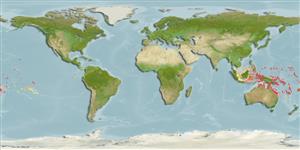>
Ovalentaria/misc (Various families in series Ovalentaria) >
Pomacentridae (Damselfishes) > Pomacentrinae
Etymology: Amphiprion: Greek, amphi = on both sides + Greek, prion, -onos = saw (Ref. 45335).
More on author: Bleeker.
Environment: milieu / climate zone / depth range / distribution range
Ecologia
marino associati a barriera corallina; non migratori; distribuzione batimetrica 1 - 18 m (Ref. 1602). Tropical; 10°N - 30°S
Pacific Ocean: Eastern Indonesia (Bali and Sulawesi eastward), south-eastern Philippines, Papua New Guinea, eastern Queensland, Coral Sea, Solomon Islands, Vanuatu, New Caledonia Palau and Islands of Micronesia.
Length at first maturity / Size / Peso / Age
Maturity: Lm 5.0, range 5 - 5.5 cm
Max length : 12.0 cm TL maschio/sesso non determinato; (Ref. 9710); Età massima riportata: 5 anni (Ref. 237)
Spine dorsali (totale): 10; Raggi dorsali molli (totale): 16-18; Spine anali 2; Raggi anali molli: 13 - 14.
Adults inhabit lagoon and outer reef environments. Feed predominantly on planktonic copepods and algae. Oviparous, distinct pairing during breeding (Ref. 205). Eggs are demersal and adhere to the substrate (Ref. 205). Males guard and aerate the eggs (Ref. 205). Associated with the anemones: Entacmaea quadricolor (usually), Heteractis crispa (occasionally), and Heteractis magnifica (rarely) (Ref. 5911). Has been reared in captivity (Ref. 35404, 35413, 35420).
Benthic spawner. Oviparous, distinct pairing during breeding (Ref. 205). Eggs are demersal and adhere to the substrate (Ref. 205). Males guard and aerate the eggs (Ref. 205). Also Ref. 7471.
Allen, G.R., 1991. Damselfishes of the world. Mergus Publishers, Melle, Germany. 271 p. (Ref. 7247)
IUCN Red List Status (Ref. 130435)
Threat to humans
Harmless
Human uses
Warning: mysqli::__construct(): (HY000/1040): Too many connections in /var/www/html/includes/func_getlabel.php on line 46
Can't connect to MySQL database (fbapp). Errorcode: Too many connections
